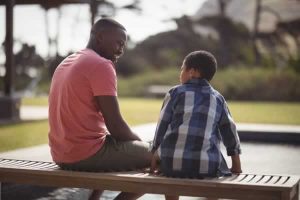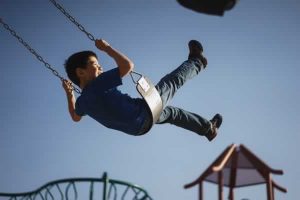Child sexual abuse is a lot more common than any of us want to believe. The truth is, it happens across communities, and countless families are blind-sided when it occurs. According to the Centers for Disease Control and Prevention (CDC), approximately 1 in 4 girls and 1 and 13 males are sexually abused before they are 18. The CDC also estimates that 91% of child sexual abuse perpetrators are not strangers (So much for stranger danger!). As a parent, this statistic is incredibly scary. If sexual abuse happens most often when our children are in places we trust, then how can we ever protect them?
 We know that putting children in a bubble (although the thought may have crossed all of our minds once or twice!) does not protect them – it just prevents them from developing into the vibrant people they are meant to be.
We know that putting children in a bubble (although the thought may have crossed all of our minds once or twice!) does not protect them – it just prevents them from developing into the vibrant people they are meant to be.
So, what can we do?!
We can educate and empower our children by making sure they know the following things:
1- They are the boss of their bodies and have the right to say no if they feel unsafe. We must make sure our children know that if a grownup who is in charge tells them to do something that is unsafe, they can always say “no.” They can also always say they want to double-check with their parent to make sure they are allowed. We often tell children that they have to listen to the person in charge, but unfortunately, this can put them at risk.
2- Anatomically correct terms for private parts (e.g., penis). Just like we teach our children the names of their nose and mouth, we need to teach them the doctor’s names for their private parts. The more comfortable they are using these terms with us, the more comfortable they will be to tell us if anything ever happens. Knowing the doctor’s names also equips them with universally understood terms in case they need to tell another adult. For example, if they say to their teacher, someone touched their “cookie,” this may not be understood, but if they say “vagina,” their message will be clear.

3- The difference between “okay” and “not okay” touches. One way we can do this is by teaching our children that the areas of their bodies that are covered by their bathing suits are their private parts. We can then explain to them that no one should touch these parts except a doctor (if their caregiver says it is okay) or a parent if they are young and ask for help cleaning themselves. We should explain to our children that sometimes their doctor may need to check their private parts to make sure they are okay, but someone “playing doctor” should not check private parts.
4- The difference between “good secrets” and “bad secrets.” Our children need to know that keeping “good secrets,” such as a birthday present, is okay. However, if someone tells them to keep a secret that makes them feel unsafe, this is a “bad secret,” and they should inform an adult.
5- What to do if they are ever in a situation where they are uncomfortable. We can help our children identify multiple people they can go to for help across locations (e.g., at school, extracurricular activities, home). We can also role-play with young children what to say if they ever want to leave a situation or need help. The more practice, the better! Sometimes children struggle to come up with the words on their own, especially in stressful situations. Lots of children also act out behavioral if they don’t know how to ask for help.

6- They can talk to us if they are ever confused about a touch. Child sexual abuse often starts with “grooming” behaviors, which children may be confused about, and they can bring to our attention. Additionally, sometimes child sexual abuse does not hurt and may even feel good. These touches further confuse children.
7- They can talk to us about not-okay touches, and we will listen without reacting. If our child comes to us and tells us about a not-okay touch, we want to thank them for telling us and let them explain what happened. When we react, children tend to shut down. With that said, not reacting can be tough sometimes. If our child tells us something happened to them, it might be difficult to contain our own emotions. If you happen to cry or get angry, it is never too late to go back and tell your child why you were upset or angry: “Mommy is upset because _____ did this to you, but she is not upset or mad at you at all. You made her proud because you told.”
8- They will not get in trouble if they ever tell you about something that made them feel unsafe or uncomfortable. Many children say they are afraid to tell because they are afraid to get in trouble, or they believe it is their fault that this happened to them. The person who gave them the not-okay touch also may have told them that they would get in trouble. We want to get ahead of this and make sure our children know that they will not get in trouble if they ever tell us about a not-okay touch or anything else that made them feel uncomfortable.
9- That we will believe them if they ever tell us something happened. I hear all the time from children that they initially did not tell because they were afraid no one would believe them. After all, in most cases, the person who touched them was someone trusted by their family. Our children need to know that we have their backs – because, well – we do. We also need to tell our children that if someone ever does not believe them, they should keep telling until someone does.
 With all this said, as we teach our children the above information – as parents – we also need to remind ourselves the following:
With all this said, as we teach our children the above information – as parents – we also need to remind ourselves the following:
1- Worrying does not prevent child sexual abuse.
2– If child sexual abuse does ever happen – just like it is not our child’s fault, it is not our fault. As much as we want to protect our children, child sexual abuse can happen even to children with the BEST parents.
3- We are not alone if this does happen. Certified therapists in Trauma-Focused Cognitive Behavioral Therapy are specially trained to help children and families recover from child sexual abuse symptoms. If you have any questions or would like additional information on child abuse prevention or treatment, reach out.
Some of these tips, as well as others, can be found at https://www.childwelfare.gov/pubPDFs/prevent_sa_ts_2020.pdf. Additionally, further information about child sexual abuse can be found at https://www.cdc.gov/violenceprevention/childabuseandneglect/childsexualabuse.html.
